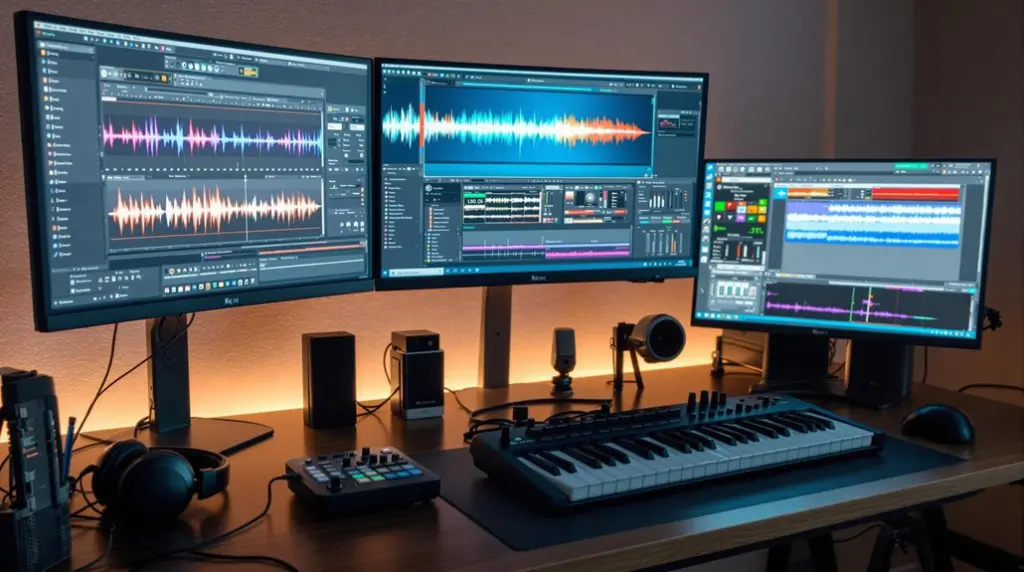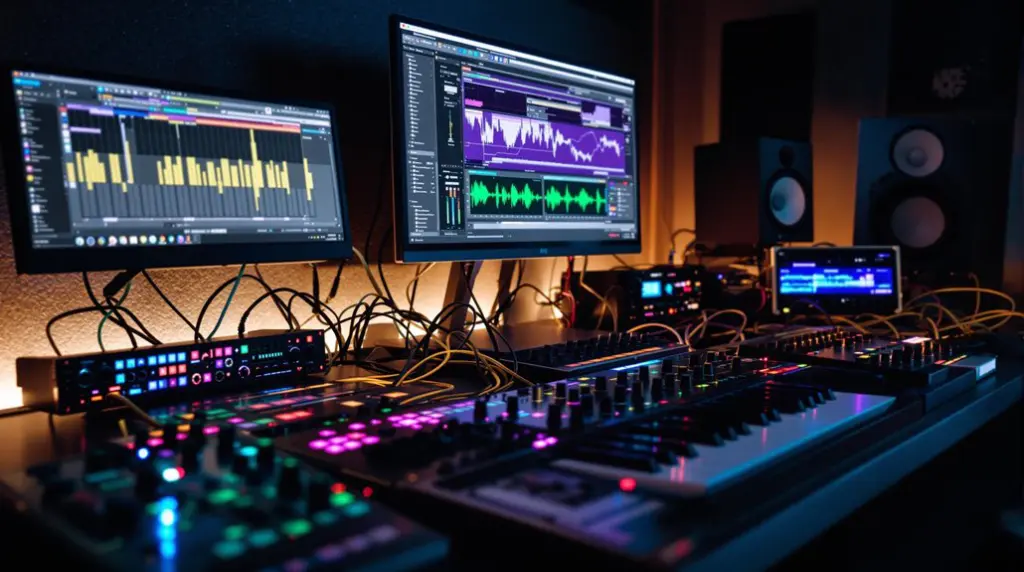The Moog Voyager synthesizer is celebrated for its rich oscillator capabilities, offering deep bass, high notes, and diverse waveform options through its three robust oscillators. Its advanced modulation options include 43 sources and aftertouch integration, enabling intricate soundscapes and customization. Superior sound quality is achieved through a classic Moog 24db lowpass filter and dynamic oscillator sync, delivering a rich, smooth, and unmistakable sound profile. These features contribute to its status as a legendary synthesizer in the music industry with much more to explore regarding functionality and creative potential.
Key Takeaways
- The Moog Voyager’s three oscillators offer versatile waveform options, including sawtooth, triangle, square, and pulse.
- The classic Moog 24db lowpass filter ensures rich, smooth sound textures and dynamic sound profiles.
- Advanced modulation options include 43 sources and four Shaper sources, allowing for complex and evolving soundscapes.
- Hard sync and frequency modulation functions provide enhanced sound design capabilities and unique tonal variations.
- The touch-screen interface allows intuitive control over oscillator levels and filter settings.
Rich Oscillator Capabilities
The Moog Voyager stands out for its exceptional oscillator capabilities, which are pivotal in shaping its rich and versatile sonic palette. Central to this are the three robust oscillators that offer a diverse array of waveform options, including triangle, sawtooth, square, and pulse. This waveform variety enables musicians to craft an extensive range of tones, from smooth and mellow to sharp and aggressive, catering to various musical genres. The high-quality virtual instruments found in professional DAWs complement these capabilities, providing an enhanced production experience.
Oscillator 1’s expanded audio octave range, spanning from 32 to 1, provides significant pitch flexibility. This broad range allows users to explore deep bass frequencies as well as piercing high notes, thereby expanding the instrument’s tonal versatility.
In addition, Oscillators 2 and 3 are equipped with fine-tuning controls, allowing precise adjustments of ±7 semitones. This feature is particularly useful for creating intricate harmonies and complex sound textures, adding depth to compositions.
The inclusion of hard sync and frequency modulation functions further enhances the Voyager’s sound design capabilities. These advanced techniques enable the production of unique timbres and textures that are essential for modern electronic music.
Advanced Modulation Options
Exemplifying a pinnacle of modern synthesis, Moog Voyager’s advanced modulation options enhance its sound design capabilities to unprecedented levels. With an impressive array of 43 modulation sources, users can craft complex and evolving soundscapes akin to those achievable with modular synthesizers. Key to this versatility are the four Shaper sources, which allow for a staggering six trillion combinations of source and destination parameters, offering a virtually limitless palette for sound design.
Moreover, the Voyager’s touch-screen interface provides intuitive control over various parameters, including oscillator levels and filter settings, considerably enhancing the modulation experience. This user-friendly interface makes real-time adjustments seamless and precise, a boon for both studio production and live performance.
For those seeking even greater expressive control, aftertouch modulation can be integrated through the VX351 CV Expander and CP251 Control Processor, enabling smoother and more dynamic modulation responses. Additionally, the Pot Mapping Source/Destination parameters facilitate independent modulation paths, empowering users with extensive control over their sonic creations.
| Feature | Description |
|---|---|
| Modulation Sources | 43 sources for complex sound design |
| Shaper Sources | Four Shaper sources with trillions of combinations |
| Touch-Screen Interface | Intuitive control over oscillator levels and filter settings |
| Aftertouch Modulation | Achieved using VX351 CV Expander and CP251 Control Processor |
| Pot Mapping | Independent modulation paths for extensive control |
This advanced modulation architecture guarantees that the Moog Voyager remains a formidable instrument for sound designers seeking unparalleled precision and creativity.
Superior Sound Quality
Renowned for its superior sound quality, Moog Voyager stands as a demonstration to the pinnacle of analog synthesis. Central to this excellence is the classic Moog 24db lowpass filter, which imparts rich and smooth sound textures that have become synonymous with the Moog brand. This filter is instrumental in providing the Voyager with a dynamic range and tonal versatility that few synthesizers can match.
The Moog Voyager features three oscillators capable of generating an extensive array of waveforms, from sine to square. This versatility enables the creation of a diverse palette of sounds, ranging from thick, resonant bass lines to intricate, shimmering leads. Users have consistently praised the Voyager’s ability to maintain lively and dynamic sound profiles, even when complex patches and modulation techniques are employed, ensuring that the instrument never falls into static or lifeless tones.
Additionally, the oscillator sync feature expands the Voyager’s sonic capabilities, allowing for the generation of crunchy FM bass sounds and unique tonal variations. The full, smooth bass and unmistakable sound profile of the Voyager set it apart from other synthesizers, making it an enduring favorite among musicians across various genres.
Frequently Asked Questions
Is Moog Voyager Worth It?
The Moog Voyager is indeed worth the investment, offering Moog legacy sound with modern enhancements. Its versatility in sound design, coupled with robust build quality and extensive modulation capabilities, provides exceptional value for serious synthesizer enthusiasts.
What Makes Moog Special?
Moog’s legacy lies in its unparalleled sound quality and innovative design. Exemplary Moog craftsmanship guarantees reliability and a distinctive analog character, making these synthesizers essential tools for electronic music, renowned for their rich timbres and robust build quality.
How Many Moog Voyagers Were Made?
Exact production numbers of the Moog Voyager remain undisclosed; however, estimates suggest thousands of units produced. Its limited runs and historical significance as one of the last major analog monosynths enhance its collectible status among enthusiasts.
How Do I Change My Moog Voyager Bank?
To change your Moog Voyager’s bank settings, press the “Bank” button, navigate using the cursor buttons, and select the desired bank by pressing “Enter.” This process enables efficient organization and retrieval, essential for thorough sound design.
Conclusion
The Moog Voyager’s status as a classic synthesizer is firmly rooted in its rich oscillator capabilities, advanced modulation options, and superior sound quality. These features collectively facilitate a wide range of sonic possibilities, making the instrument a versatile tool for both experimental and traditional music production. The Voyager’s robust design and technical sophistication guarantee its enduring relevance and appeal within the landscape of electronic music instruments.




